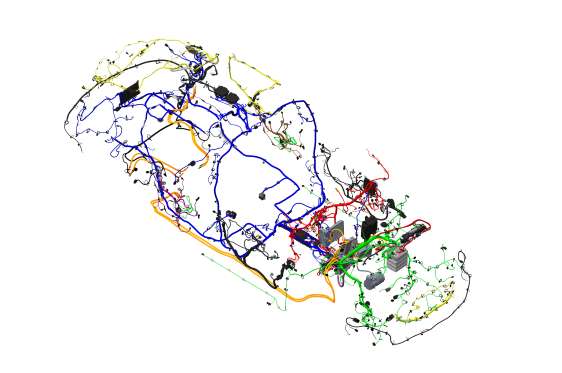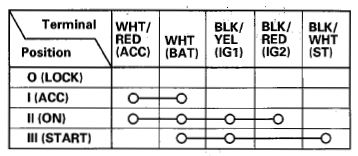Typical (as seen to the right) conventional electrical wiring in modern
cars is very complex and runs to almost every corner of the car and though
manufacturers are starting to use smaller guage of wires its still
 can be of
some weight. can be of
some weight.
Therefore wiring will be eliminated to use as view wires as possible and its its
place a custom communication bus with modules throughout the car be
utilized to control various elements like lights and controls. Benefit of it
will be that all control lines will be practically eliminated and power carrying
wiring will be reduced to just couple of feet to between modules and controlled
devices. They will also can be reduced in guage as the drop on wire will not be
as great due to the length of the power wire. Benefit of it will be that
overall electrical system will be much lighter due to lower count of cabling.
Trouble shooting of electrical system will be greatly improved at same time.
Since all
systems will be linked via single communication bus, sharing sensor and data
collecting inputs can be shared between processing modules and processed for
different operating condition. One example of it is the
Gear Selector Indicator tough in this version it does not indicate
communication bus connection.
Other example is the window drop circuit. In some
circumstances it is required to drop door window my an inch so that when opening
door it will not interfere with door or window weather stripping then bring the
window to a close when door is closed shut. This could also can be added to any
OEM cars as add-on or with combination to alarm to either raise or drop the
window.
Steering Column
Looking around for a short steering column that would fit in and clear
pedals yet still have modern look was a bit of a chore as most North American
sources had long columns before 1st U joint, same went for European
counterparts. One choice was from Acura 04-06 TL which has a very short column,
tilt and telescopic option and also the column controls are fairly good looking.
Other option is from Honda Accord 04-07 which is basically as the TL but with
bit different stock look.
 Ignition
Switch Ignition
Switch
It seems like the single simples thing is the ignition switch.
Figure to the right shows wire color map and with only 5 wires it controls power
to particular position: Accessory I, Accessory II one which turns off during cranking and
one that is on during cranking and a starter to crank the engine. Very straight
forward like all other key switches.
Wiper & lights / turn signal control
The problem comes with the output from those switches. For some reason Honda
decided to multiples the switch signals via microcontroller mounted in the wiper
switch fed via CAN but into fuse box that they are calling it Multiplex
Integrated Control Unit (MICU). To make
things a bit worse they had decided to use Philips AU5790D
or alternative TH8065
single wire CAN controller that is connected through 8 pin connector on the
wiper switch where only 6 pins are used. It would had been so much easier if
they had used differential (high - low) bus. The traditional way would had been to
have individual wires from the switches going to according circuits however that
would end up with around 14 wires. Not extremely large amount especially if you
think that there is already an 8 pin connector used between the switch and MICU.
So came few questions:
1) Should the column and the switches be replaced as putting alternative
switches on the column be probably impossible to find switch with same mounts.
2) Should the control board be replaced with custom one and more suitable
interface ie normal CAN bus interface or LIN or K-bus
3) Alternative option is to decode the bus protocol and make custom decoder with
specific outputs or control module
4) Other option is to use the Honda MICU fuse box and hopefully it will work as
designed and not need any other modifications to it ie immobalizer. This probably
is the least amount of work but will have to locate one box and try it out.
More on this in fuse boxes
Fuse Box - interior
There are a lot of fuse boxes that are ready made, pre-wired and labeled.
Problem with them is that they are generally expensive $400 + for a basic
configuration it does come with the basic turn and hazard flashers however if
you are looking for relays then you are looking to add some extra $$ to the price tag
if you like it all integrated in a single box or use external relays that will
make the wiring look like cow pies
Since we are are using Honda/Acura steering column and switch stock that
comes with it so may as well use the interior fuse block from that vintage of car.
After looking at the fuse box we had discovered advatages and disadvantages of
it;
Pro:
- lots of 33 small blade fuses
- build in turn / hazard flasher
- build in relays for fuel pump, etc...
- wire are organized into buses/locations for interior of the car and are connected through
connectors into the box
Con:
- no direct control / connection from stock switches for headlights / turn,
wiper etc..
- internal control board needs to be reprogrammed or custom one to be made
- not the smallest in size and rather bulky with all of the connectors
Despite of the short comings, sample was acquired and work had started to
reverse engineer it. Work on the process can be found on this
link
Fuse Box - engine bay
With all latest engines they are controlled by computers and have different
circuit paths for various valves pumps etc... and need to be protected and
switched on and off so an engine bay fuse box with relays is required. The
problem is with exception of very few cars most are front engined and here is
where the problem bigins. Their configuration includes circuits for things like
front and rear lights, horn and some even have circuits for other body
controls. More link
Instrument cluster
With the size of the interior a standard cluster could not be used, A lot of
ideas was thrown around how to make it. Starting from reusing some of the parts
from OEM clusters to individual guages. The problem with both and the latter one
is that the cluster would look like something a shade tree mechanic would gobble
it together with help of some glue and tape. So the only option was to go a
custom route. More information on the
link
HVAC
Control module for heat and AC controls. Setup for push buttons rather then
rotary knows controlling all aspects of the system from input , display and
drivers for motors with capability for dual zone control though may not be
implemented in final product
Door control module
While looking at the interior fuse block, it had 2 dedicated connectors with 40
wires in the bundle going to the drivers (left) door though it does have the
keyless entry module hence why so many. Passanger door (right) has considerably
less and even less in the rear doors. To its defense it did came from a 4 door
car, but never the less.. Not sure if the difference between the amount of wires
and the door control module would be of great savings in weight but looking at
more electronically controlled car desition was made to move forward with the
control module and more information is on this
link.
Head & Fog Lights
Section encompasses on all front lighting systems. Starting with marker lights ,
main beams to suplemental marker lights and turn signals
Brake intake splitter (front
marker light)
Final version had not changed since prototype version and rather then of
repeating prototype can be found <here>.
Though a version 2 of the light board was looked into which used RGB LED's so
that different colors could be mixed. However it was never made
Rear Lights
Two options for rear lights are being investigated. |
 can be of
some weight.
can be of
some weight.